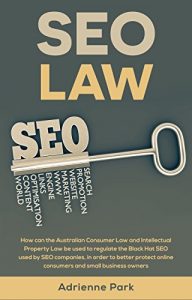Google created the need for Search Engine Optimisation ('SEO') and SEO professionals to help increase website ranking among more than one million websites in Google. There are three types of SEO strategies: White Hat SEO (‘WHSEO’), Black Hat SEO (‘BHSEO’), and Grey Hat SEO('GHSEO'). While there is no clear legal definition of WHSEO, it can be explained as a positive SEO strategy, operated by a human, which improves the search engine performance on a SERP. BHSEO strategies are the opposite of WHSEO and include cybersquatting, abusing meta tags, creating fake reviews to receive backlinks, sending fake website traffic, content farms and using spammy linkbuilding methods. The reasons a business owner may pursue BHSEO are for the advantages of cost efficiency, requiring short periods of time to increase PR, and the campaigns are easy to maintain by software. Unfortunately, there are many SEO companies that fail to reach their intended achievement within a certain period of time. This may result in engaging in misleading or deceptive conduct under the Australian Consumer Law (‘ACL’) or a breach of Intercultural Property Law (‘IPL’).
In 1991, there was only one website. It was known as the World Wide Web and was invented by Tim Berners-Lee. According to the results of a survey by Netcraft, there are now, in 21st century over one billion websites on the World Wide Web. Since Google was launched in 1998, it has become the world number one search engine site. Although, Google created the need for Search Engine Optimisation ('SEO') and SEO professionals to help increase website ranking among more than one million websites in Google, the term 'Search Engine Optimisation' appeared before Google was established. It is possible that the term was first used by John Audette in a meeting with Danny Sullivan in 1997 or in the same year by Bruce Clay, these people being the first practitioners of the SEO internet skill. Throughout the history of SEO use, many issues have been raised due to the use of Black Hat SEO ('BHSEO') which delivers poor website rankings for small business owners and their clients. This research paper will discuss what White Hat SEO ('WHSEO') and BHSEO are. In particular, it will review and analyse if there are problems with BHSEO strategies under the current Australian Consumer Law ('ACL') and Australian Intellectual Property Law ('IPL'). The paper will also suggest possible reforms in order to further protect business owners and online consumers in the current online market.
In 1991, there was only one website. It was known as the World Wide Web and was invented by Tim Berners-Lee. According to the results of a survey by Netcraft, there are now, in 21st century over one billion websites on the World Wide Web. Since Google was launched in 1998, it has become the world number one search engine site. Although, Google created the need for Search Engine Optimisation ('SEO') and SEO professionals to help increase website ranking among more than one million websites in Google, the term 'Search Engine Optimisation' appeared before Google was established. It is possible that the term was first used by John Audette in a meeting with Danny Sullivan in 1997 or in the same year by Bruce Clay, these people being the first practitioners of the SEO internet skill. Throughout the history of SEO use, many issues have been raised due to the use of Black Hat SEO ('BHSEO') which delivers poor website rankings for small business owners and their clients. This research paper will discuss what White Hat SEO ('WHSEO') and BHSEO are. In particular, it will review and analyse if there are problems with BHSEO strategies under the current Australian Consumer Law ('ACL') and Australian Intellectual Property Law ('IPL'). The paper will also suggest possible reforms in order to further protect business owners and online consumers in the current online market.












